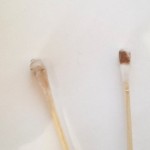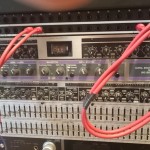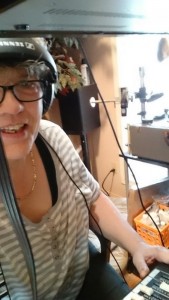From time to time, we get calls or emails from enthusiastic young man and women asking for a trainee, apprenticeship or job at Rollofone. Listening to great music and hanging out with the rich and famous – who wouldn’t want to do that?
Unfortunately, there’s much less glamour attached to the job. Sure – there are a few of us who do interact with the “stars” frequently – but for the most of us, that just doesn’t happen. Especially not in specialized studios such as ours. Our “stars” are, unfortunately, long gone. So we mostly work with the legacy they have left us – which is of course very rewarding.
So – what do we do all day?
 Well – the day starts with a look at what we call “the score board”. It shows what we’re planning to do today. We sometimes have to go places to record a performance, on other days artists or producers come to see how their work is proceeding. Usually we have copy, transfer, cutting or restore jobs on the schedule. In order to do our work, all the systems and units have to be clean, adjusted and ready, So – the reel to reel machines have to be cleaned, an alignment tape is played and the machines have to be adjusted if necessary. The image shows the dirt we get just after a few tape spins. We check the recording lathe, clean the suction system and verify the cutting stylus under a microscope.The audio chain is prepared – the channels patched to the setting we need and all functions are verified with test signals.
Well – the day starts with a look at what we call “the score board”. It shows what we’re planning to do today. We sometimes have to go places to record a performance, on other days artists or producers come to see how their work is proceeding. Usually we have copy, transfer, cutting or restore jobs on the schedule. In order to do our work, all the systems and units have to be clean, adjusted and ready, So – the reel to reel machines have to be cleaned, an alignment tape is played and the machines have to be adjusted if necessary. The image shows the dirt we get just after a few tape spins. We check the recording lathe, clean the suction system and verify the cutting stylus under a microscope.The audio chain is prepared – the channels patched to the setting we need and all functions are verified with test signals.
If all checks out, we’re ready to start the music work around 10:30am.
But we discovered a problem today. Some slight scratching in the left channel of one of the tape units we were planning to use today (Otari MX-5050) . It took about an hour to trace – and turned out to be a bad slider on the mixer. So we disconnected that channel and routed it through another mixer. And at around 11:30am, the tape started spinning. The studio was flooded with a beautiful recording of Brahm’s Symphony No. 4 .The mastering units in this job, a Behringer Ultra Gain, Aphex 104 and a dbx full octave eq – carefully adjusted to add just a touch of improvement to enhance the limitations of the vintage 7 1/2 IPS tape.
During the transfer and re-mastering one has to take special care of the stereo signal. Vintage tapes tend to lose signal strength and sometimes more on one channel. So – I have to monitor the recording and adjust for unequal signals on the stereo channel.
 While this symphony is being recorded, I check emails and prepare a few images for Rollofone’s download section. In between I flip the tape and record the second side. It is lunch time after the symphony is safely stored on a digital media. While I am out to grab a bite, my digital recording is listened to in our listening room. It’s always a great experience to listen to the music in a (more or less) sound proof room with those mighty McIntosh speakers. The sound file (recorded in 16bit PCM at 96Khz) gets “thumbs up” and it is stored on a special computer where it will be converted into a loss-less digital format (FLAC).
While this symphony is being recorded, I check emails and prepare a few images for Rollofone’s download section. In between I flip the tape and record the second side. It is lunch time after the symphony is safely stored on a digital media. While I am out to grab a bite, my digital recording is listened to in our listening room. It’s always a great experience to listen to the music in a (more or less) sound proof room with those mighty McIntosh speakers. The sound file (recorded in 16bit PCM at 96Khz) gets “thumbs up” and it is stored on a special computer where it will be converted into a loss-less digital format (FLAC).
Some “urgent” job bumps into the “to do” list for today. A customer needs two records cut by end of business. So – the CDs is ripped and transferred to the cutting system. I am listening to the song a few times, adjust the “Composer Pro” because the song has a few nasty sibilants and finally pipe it to the inverse RIAA encoder for cutting. Cutting PVC always needs a little more attention because it attracts static charges that may mess up suction or even the recording. But everything went well and the records were ready to go around 3pm.
 A few phone calls and I am back at the tape machine. This time it’s a Prokofiev Symphony on an old 3 3/4 inch tape. I carefully inspect the tape for signs of disintegration – I don’t want some old tape gooey on my heads. The tape is re-mastered and ready for conversion around 5:30pm. I take another hour or so on the DAW (Digital Audio Workstation) to work on my pet project – restoring very, very old 78rpm recordings (see Rollofon’s Vault) . At around 7pm I call it a day.
A few phone calls and I am back at the tape machine. This time it’s a Prokofiev Symphony on an old 3 3/4 inch tape. I carefully inspect the tape for signs of disintegration – I don’t want some old tape gooey on my heads. The tape is re-mastered and ready for conversion around 5:30pm. I take another hour or so on the DAW (Digital Audio Workstation) to work on my pet project – restoring very, very old 78rpm recordings (see Rollofon’s Vault) . At around 7pm I call it a day.
No mangling with rich or famous people today. I worked on Brahms and Prokofiev classical music, some country, a beautiful recording of Benny Goodman music (performed by members of the Benny Goodman Band) and a 1914 shellac record of the “Tipperary” song.
To be an audio- / master engineer you have to love music. All kinds of music. We do what we do not because we are planning on becoming rich. We do it, because we love music. We appreciate the artists and their work and do our best to make their performances sound as nice as possible. Though I personally don’t “like” all kinds of music. I am still able to appreciate it and give it my best. After all, the artists didn’t create the music for me.
So – please .. if you love music, if you don’t mind long hours and not to use your phone or tablet in the studio (no wireless technology allowed because of interference), if you have a basic understanding of electronics and are willing to use a soldering iron once in a while, if you’re happy to listen to a particular tune over and over again, if you can give it all of what it needs regardless whether you like the music or not, well, maybe you should become an audio engineer.

if I was younger I’d hop right into that!